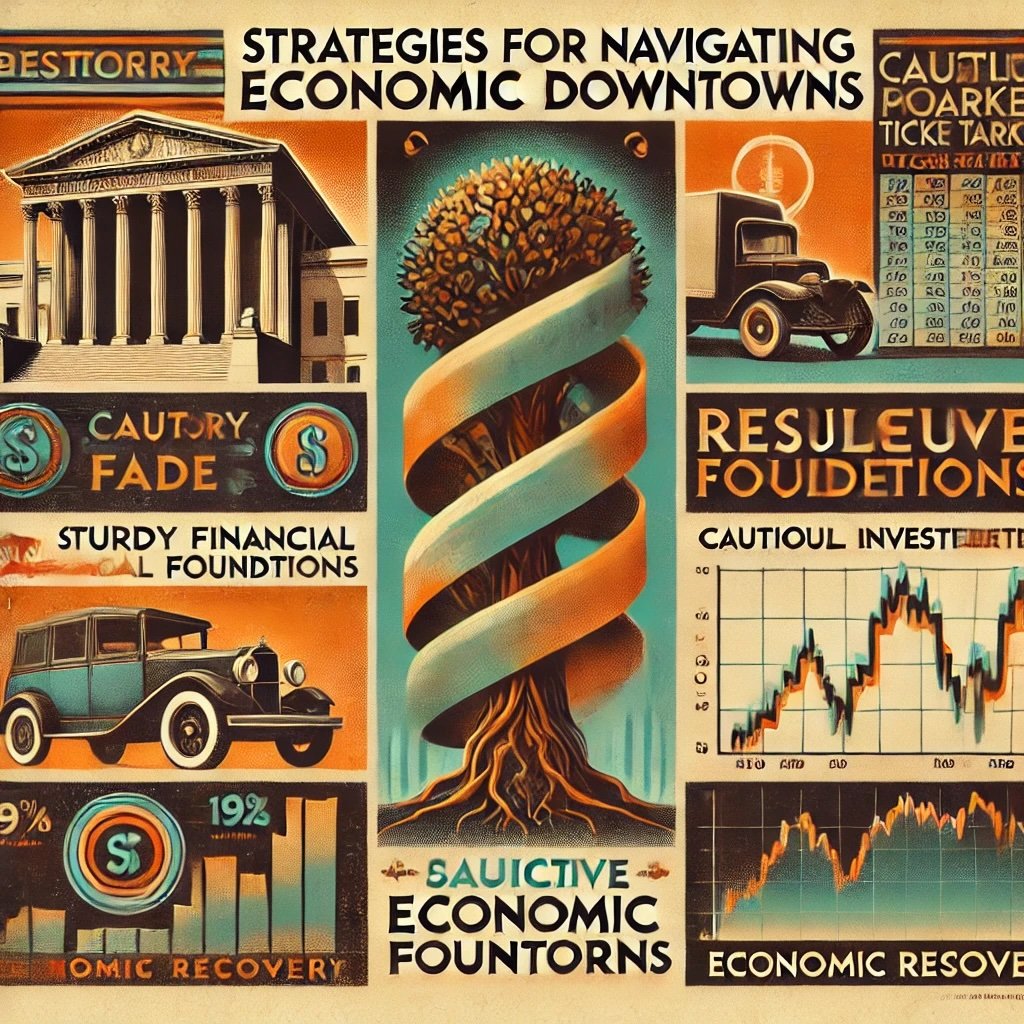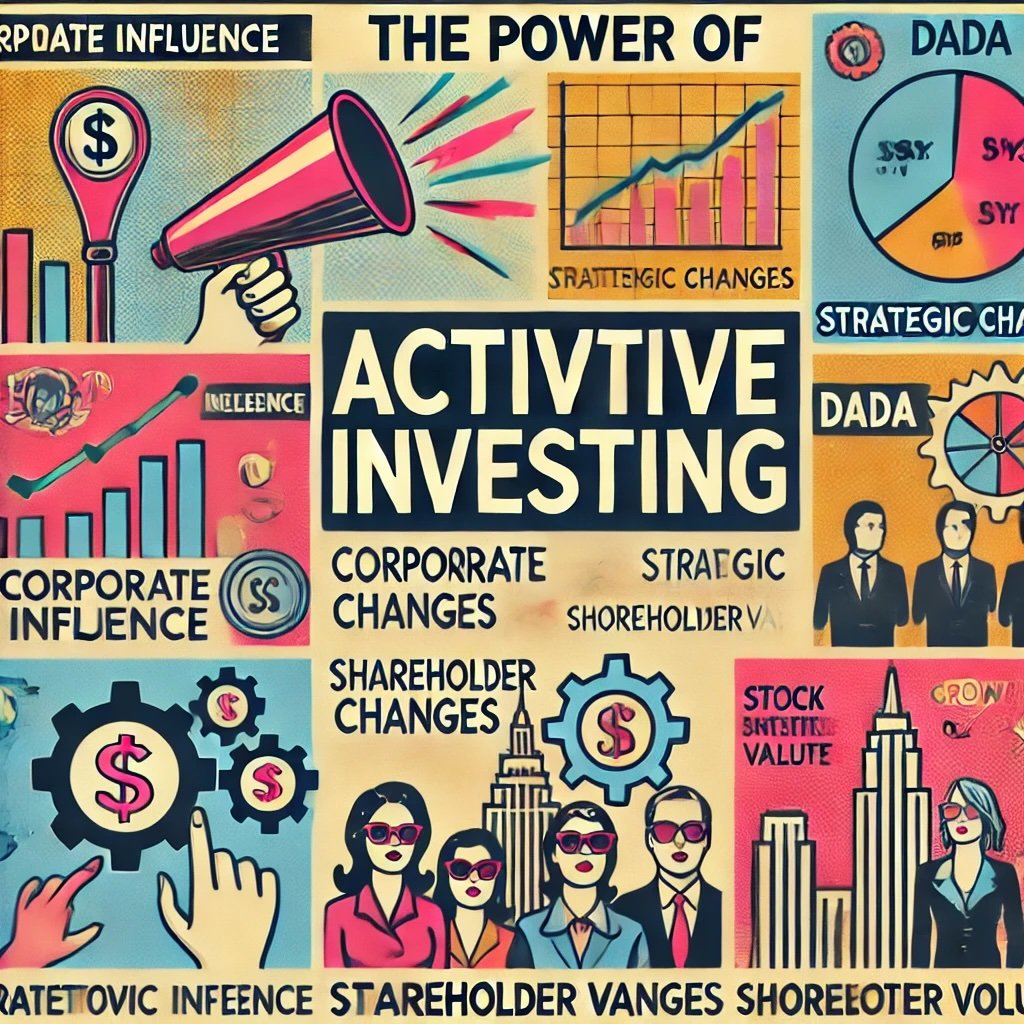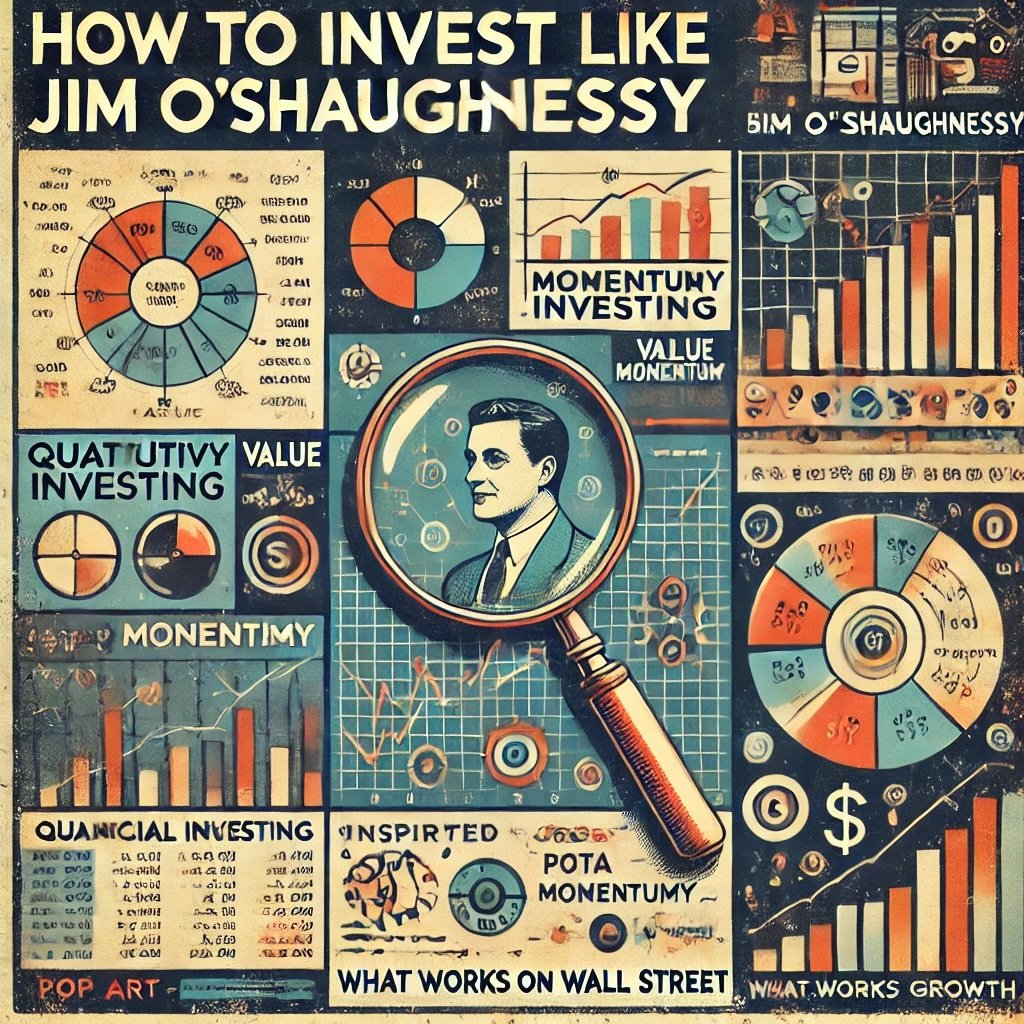Severe economic downturns can have a profound impact on both businesses and investors, shaking the very foundations of the global economy. During these challenging times, companies may face declining revenues, reduced consumer spending, and increased operational costs, making it difficult to maintain profitability. Investors, on the other hand, often experience significant losses in their portfolios, leading to diminished confidence and financial strain. The ripple effects of economic downturns extend beyond the financial sector, influencing employment rates, consumer behavior, and even political stability. Understanding the dynamics of these downturns is crucial for anyone looking to navigate the unpredictable waters of the economy.

Strategies for surviving downturns are not just beneficial—they are essential for ensuring long-term success and resilience in the face of adversity. Without effective strategies, businesses may struggle to survive, and investors might find their hard-earned savings dwindling. Warren Buffett, renowned for his investment prowess, has consistently demonstrated an exceptional ability to navigate economic challenges. His insights and strategies provide a blueprint for enduring and even thriving during tough economic times. By studying Buffett’s approach, both businesses and individual investors can gain valuable lessons on maintaining stability and achieving growth despite economic headwinds. Buffett’s expertise in managing through downturns underscores the importance of preparation, strategic planning, and emotional resilience in safeguarding against financial turmoil.
- Economic Impact: Downturns lead to reduced revenues and increased operational challenges for businesses.
- Investor Losses: Significant portfolio losses can diminish confidence and financial stability.
- Warren Buffett’s Expertise: Demonstrates effective navigation through economic challenges.
Tip: Prepare for economic downturns by developing robust strategies that emphasize resilience and adaptability, ensuring your business and investments can withstand financial turbulence.

The Significance of Economic Downturns
This article aims to highlight Warren Buffett’s proven tips and strategies for enduring economic hardships, offering a comprehensive guide for both businesses and individual investors. Buffett’s methodologies are rooted in decades of experience and have been tested through numerous economic cycles, making his insights incredibly valuable for those looking to safeguard their financial future. By demonstrating how his principles can be applied, the article provides actionable advice that readers can implement to protect and grow their investments during tough times. Buffett’s strategies emphasize the importance of patience, disciplined investing, and focusing on long-term value, which are critical components for weathering financial storms. Additionally, the article will explore practical examples of how Buffett has successfully navigated past downturns, offering real-world applications of his theories.
Setting the stage for a deep dive, the discussion will delve into specific methodologies that Buffett employs, such as identifying undervalued assets, maintaining liquidity, and prioritizing quality over quantity in investments. By understanding these approaches, readers can better prepare themselves to face future economic challenges with confidence and strategic insight. The purpose is not only to educate but also to inspire individuals and businesses to adopt Buffett’s time-tested strategies, fostering a mindset geared towards resilience and sustained growth. Ultimately, this article seeks to empower readers with the knowledge and tools necessary to thrive even in the most adverse economic conditions, mirroring the success of one of the greatest investors of our time.
- Actionable Advice: Provides practical tips that can be implemented to protect and grow investments.
- Real-World Examples: Showcases how Buffett successfully navigated past downturns.
- Strategic Insight: Offers in-depth exploration of Buffett’s methodologies for enduring financial storms.
Tip: Adopt Warren Buffett’s disciplined and long-term investment strategies to build a resilient portfolio that can withstand economic downturns and capitalize on opportunities for growth.

Understanding Economic Downturns
Types of Economic Downturns
Economic downturns come in various forms, each presenting unique challenges to businesses and investors alike. Recessions are typically defined by two consecutive quarters of negative GDP growth and are characterized by widespread declines in consumer spending, investment, and industrial production. Depressions, on the other hand, are more severe and prolonged than recessions, often lasting several years with significant declines in economic activity, high unemployment rates, and drastic reductions in consumer and business confidence. Market corrections refer to short-term declines in stock prices, usually by 10% or more from recent highs, and are often seen as natural adjustments within the market rather than indicators of broader economic malaise. Each type of downturn demands a different strategic approach to navigate successfully.
Warren Buffett adapts his investment strategies based on the specific nature of the downturn, leveraging his deep understanding of market dynamics and economic indicators. During recessions, Buffett focuses on acquiring high-quality companies at discounted prices, taking advantage of reduced valuations. In the case of depressions, his approach becomes even more conservative, prioritizing businesses with strong cash flows and resilient business models that can withstand prolonged economic stress. For market corrections, Buffett often remains patient, avoiding panic selling and instead looking for opportunities to reinforce his positions in solid investments. By tailoring his strategies to the type of economic downturn, Buffett ensures that his investments are well-positioned to recover and thrive once the economy begins to rebound. This nuanced approach highlights the importance of flexibility and informed decision-making in maintaining investment resilience during varying economic conditions.
- Recessions: Characterized by two consecutive quarters of negative GDP growth and widespread declines in economic activity.
- Depressions: More severe and prolonged than recessions, involving significant and sustained economic decline.
- Market Corrections: Short-term declines in stock prices, typically around 10%, reflecting natural market adjustments.
Tip: Understand the specific characteristics of each type of economic downturn and tailor your investment strategies accordingly to maximize resilience and capitalize on opportunities during challenging times.

Historical Context: Buffett’s Response to Past Downturns
Warren Buffett has successfully navigated through some of the most significant economic downturns in modern history, each providing valuable lessons and shaping his current investment strategies. During the Great Depression, Buffett observed firsthand the devastating impact of economic collapse and learned the importance of investing in fundamentally strong businesses that can endure extreme financial stress. This experience instilled in him a cautious approach, emphasizing the need for a solid financial foundation and the avoidance of overleveraged companies. Fast forward to the Dot-com Bubble of the late 1990s and early 2000s, Buffett remained skeptical of the speculative frenzy surrounding technology stocks, choosing instead to focus on industries with proven track records and sustainable business models. His decision to avoid overvalued tech companies during this period underscored his commitment to value investing principles and his ability to resist herd mentality.
The 2008 Financial Crisis further tested Buffett’s strategies, as he capitalized on distressed assets and provided liquidity to businesses struggling to survive. By maintaining a long-term perspective and leveraging his capital reserves, Buffett not only protected his investments but also helped stabilize key industries during the crisis. These historical experiences have honed Buffett’s ability to remain calm and disciplined during economic turmoil, reinforcing his belief in the importance of patience, due diligence, and strategic asset allocation. Today, Buffett’s strategies are heavily influenced by these past downturns, ensuring that he is well-prepared to handle future economic challenges with the same level of expertise and resilience. His ability to learn from history and apply those lessons continues to make him a formidable force in the investment world, inspiring countless investors to adopt similar approaches in their own financial journeys.
- Great Depression: Learned the importance of investing in fundamentally strong businesses.
- Dot-com Bubble: Focused on sustainable business models over speculative tech stocks.
- 2008 Financial Crisis: Capitalized on distressed assets and provided liquidity to struggling businesses.
Tip: Draw lessons from past economic downturns by analyzing successful strategies employed by seasoned investors like Warren Buffett, and incorporate these insights into your own investment approach to enhance resilience and long-term success.

Buffett’s Investment Strategies During Downturns
Buying Quality at Discounted Prices
Warren Buffett’s strategy of buying quality at discounted prices is a cornerstone of his investment philosophy, especially during economic downturns. Buffett meticulously identifies undervalued stocks that possess strong fundamentals, such as robust earnings, solid management, and durable competitive advantages. He believes that downturns present unique opportunities to acquire high-quality businesses at prices below their intrinsic value, allowing investors to maximize returns when the market recovers. Patience and timing are crucial in this approach; Buffett waits for the right moment when the market sentiment drives prices down unjustly, enabling him to invest in companies that are fundamentally sound but temporarily out of favor. For example, during the 2008 Financial Crisis, Buffett seized the opportunity to invest in companies like Goldman Sachs and General Electric, which were undervalued but had strong market positions and potential for recovery.
This strategy not only mitigates risk by focusing on businesses with proven resilience but also enhances the potential for substantial long-term gains. Buffett’s disciplined approach ensures that his investments are well-positioned to thrive once the economic conditions improve, reinforcing his reputation as a savvy investor who capitalizes on market inefficiencies. By prioritizing quality over quantity, Buffett avoids the pitfalls of speculative investments that may falter during downturns, ensuring that his portfolio remains robust and growth-oriented. This method underscores the importance of thorough research and a deep understanding of the businesses in which one invests, allowing for informed decisions that align with long-term financial goals. Ultimately, Buffett’s focus on buying quality at discounted prices exemplifies his ability to navigate economic challenges with confidence and strategic foresight.
- Undervalued Stocks: Identifies high-quality businesses priced below their intrinsic value.
- Patience and Timing: Waits for optimal moments to invest when prices are unjustly low.
- Strong Fundamentals: Focuses on companies with robust earnings and solid management.
Tip: Conduct thorough research to identify undervalued stocks with strong fundamentals, and remain patient to capitalize on market opportunities during economic downturns.

Focusing on Long-Term Value
Warren Buffett’s emphasis on focusing on long-term value sets him apart from many investors who seek quick profits. Buffett targets investments that promise sustainable growth, rather than those that offer immediate but fleeting returns. He avoids speculative and high-risk ventures, understanding that such investments are more likely to falter during economic downturns. By maintaining a long-term perspective, Buffett mitigates risks and enhances returns, as he allows his investments the time needed to realize their full potential. This approach involves holding onto quality businesses through market fluctuations, trusting in their ability to recover and grow over time.
For instance, Buffett’s investment in Coca-Cola during the early 1980s is a prime example of his long-term focus, as the company’s enduring brand strength and global presence continued to drive growth decades later. Buffett’s strategy reduces the impact of short-term market volatility, as he remains committed to the underlying value of his investments rather than reacting to temporary setbacks. This disciplined approach not only preserves capital but also leverages the power of compound growth, significantly boosting overall portfolio performance. By prioritizing long-term value, Buffett ensures that his investments are aligned with sustainable business practices and resilient market positions, fostering enduring success. This mindset encourages investors to look beyond immediate market trends and focus on the fundamental strengths that will drive growth and profitability in the years to come.
- Sustainable Growth: Invests in companies with the potential for long-term expansion.
- Avoids Speculation: Steers clear of high-risk ventures that lack solid fundamentals.
- Compound Growth: Leverages the power of time to enhance investment returns.
Tip: Adopt a long-term investment perspective by focusing on companies with sustainable growth potential and avoiding speculative, high-risk ventures that may not endure economic downturns.
Maintaining Liquidity and Cash Reserves
Maintaining liquidity and cash reserves is another key element of Warren Buffett’s strategy for surviving economic downturns. Cash provides the flexibility needed to seize investment opportunities as they arise, especially when markets are volatile and asset prices are depressed. Buffett emphasizes the importance of having sufficient cash on hand, allowing him to act swiftly without the need to sell existing investments at unfavorable prices. This approach ensures that his portfolio remains adaptable, capable of responding to changing economic conditions with agility and confidence. To build and preserve cash reserves, Buffett employs disciplined saving and strategic capital allocation, prioritizing liquidity without compromising on investment quality.
During downturns, having ample cash reserves allows Buffett to invest in undervalued opportunities without disrupting the overall stability of his portfolio. Buffett’s prudent cash management practices not only safeguard his investments during economic uncertainty but also position him to capitalize on market recoveries with well-timed purchases. This focus on liquidity reduces the need for panic selling, which can lead to significant losses and missed opportunities. By maintaining a robust cash reserve, Buffett ensures that he can navigate economic downturns with resilience and strategic insight, reinforcing the long-term strength of his investment portfolio. Ultimately, Buffett’s approach to liquidity and cash management highlights the critical role of financial flexibility in weathering economic storms and achieving sustained investment success.
- Investment Flexibility: Enables swift action on opportunities without needing to sell assets.
- Disciplined Saving: Prioritizes building cash reserves through strategic saving and allocation.
- Risk Mitigation: Reduces the need for panic selling during market downturns.
Tip: Ensure you have sufficient cash reserves to take advantage of investment opportunities during economic downturns, providing flexibility and reducing the need to sell assets under pressure.

Managing Risk and Protecting Capital
Diversification vs. Concentration
Warren Buffett’s approach to managing risk and protecting capital is a fascinating blend of diversification and concentration, tailored to maximize returns while minimizing potential losses. Diversification involves spreading investments across various sectors and asset classes to reduce exposure to any single investment’s poor performance. While this strategy can lower risk, it often leads to average returns because high-performing investments are diluted by mediocre ones. On the other hand, Buffett prefers a more concentrated investment approach, focusing on a smaller number of high-conviction stocks that he thoroughly understands and believes in. He invests heavily in businesses with strong fundamentals, competitive advantages, and reliable management teams, ensuring that each investment has the potential to generate substantial returns. This concentration allows Buffett to capitalize on his deep knowledge of specific industries and companies, enhancing the likelihood of selecting winners that can withstand economic downturns.
However, this approach also carries inherent risks, as the performance of a few investments can significantly impact the overall portfolio. Balancing diversification with concentration requires a keen understanding of each investment’s potential and the ability to manage and mitigate associated risks effectively. During economic downturns, Buffett’s concentrated investments in resilient businesses help protect his capital and provide stability, while a diversified portfolio might struggle under the weight of underperforming assets. By carefully selecting high-quality investments and maintaining a focused portfolio, Buffett demonstrates how concentration, when applied judiciously, can lead to superior performance and enhanced capital protection. Ultimately, his strategy underscores the importance of knowing your investments deeply and having the confidence to hold onto them through market fluctuations, rather than spreading too thin across numerous assets.
- Focused Investments: Concentrates on high-conviction stocks with strong fundamentals.
- Risk Mitigation: Reduces exposure to underperforming assets through selective investing.
- Enhanced Returns: Leverages deep industry knowledge to identify and invest in potential winners.
Tip: Strike a balance between diversification and concentration by investing in a select number of high-quality businesses you thoroughly understand, ensuring robust returns while managing risk effectively.

Hedging Strategies
While diversification and concentration are key elements of Buffett’s strategy, he takes a more nuanced stance on hedging strategies. Hedging involves using financial instruments like options and futures to protect against market volatility and potential losses. Buffett acknowledges the role of hedging in managing risk, but he prefers to rely on other risk management techniques that align more closely with his investment philosophy. He believes that purchasing quality assets at reasonable prices inherently provides a natural hedge against market downturns, as these investments are more likely to recover and perform well over time. Instead of actively hedging, Buffett focuses on maintaining a strong understanding of his investments and ensuring they possess the durability to withstand economic shocks. This approach minimizes the need for complex hedging strategies, which can be costly and may detract from overall returns if not executed perfectly.
Buffett’s preference for simplicity and clarity in his investment strategy means he avoids the intricacies and potential pitfalls associated with hedging, opting instead to invest in businesses with solid fundamentals and long-term growth prospects. However, he does not entirely dismiss the utility of hedging; rather, he reserves its use for specific situations where it can add genuine value without compromising his investment principles. Practical hedging strategies that align with Buffett’s principles include maintaining ample cash reserves and investing in companies with strong balance sheets, which provide a buffer during volatile periods. By focusing on these foundational risk management techniques, Buffett ensures that his portfolio remains resilient and adaptable, capable of weathering economic uncertainties without the need for excessive hedging. This disciplined approach to risk management underscores the importance of simplicity and strategic foresight in protecting capital and achieving sustained investment success.
- Natural Hedging: Invests in quality assets that inherently provide protection against downturns.
- Simplicity Over Complexity: Avoids intricate hedging instruments in favor of straightforward risk management.
- Strong Fundamentals: Relies on businesses with solid financial health to mitigate risks naturally.
Tip: Focus on investing in high-quality, resilient businesses and maintain sufficient cash reserves to provide a natural hedge against market volatility, reducing the need for complex hedging strategies.
Avoiding Common Pitfalls and Emotional Decisions
One of the most critical aspects of Buffett’s approach to managing risk is avoiding common pitfalls and emotional decisions that can derail investment strategies during downturns. Panic selling and following the herd mentality are two major traps that Buffett consciously avoids, recognizing that reacting impulsively to market fluctuations often leads to significant losses. Instead of succumbing to fear, Buffett remains calm and rational, sticking to his well-thought-out investment plan regardless of short-term market movements. This discipline is crucial in protecting capital, as it prevents investors from making hasty decisions based on temporary setbacks or market hysteria. Buffett emphasizes the importance of maintaining a clear, objective perspective, focusing on the intrinsic value of investments rather than being swayed by external noise or speculative trends.
By staying committed to his investment principles, Buffett ensures that his decisions are driven by logic and analysis rather than emotions, which can cloud judgment and lead to costly mistakes. He also advocates for thorough research and due diligence, encouraging investors to understand their investments deeply and make informed choices based on solid fundamentals. Buffett’s rational approach helps him avoid the pitfalls of overconfidence and underestimating risks, fostering a stable and resilient investment portfolio. Additionally, he stresses the importance of patience, allowing investments the time they need to grow and perform, rather than chasing quick returns that may not be sustainable. By steering clear of emotional biases and adhering to a disciplined investment strategy, Buffett exemplifies how rationality and perseverance can safeguard capital and drive long-term success, even in the face of economic adversity.
- Avoids Panic Selling: Maintains calm and sticks to the investment plan during market downturns.
- Disciplined Approach: Follows a well-thought-out strategy based on fundamentals.
- Thorough Research: Emphasizes understanding investments deeply to make informed decisions.
Tip: Stay disciplined and avoid emotional reactions by adhering to your investment plan, conducting thorough research, and focusing on the long-term fundamentals of your investments during economic downturns.

Leveraging Buffett’s Wisdom on Business Fundamentals
Investing in Strong Business Models
Warren Buffett’s success is deeply rooted in his ability to identify and invest in companies with resilient and adaptable business models. He meticulously analyzes how a business generates revenue, sustains its operations, and maintains profitability over the long term. Buffett looks for companies with clear and sustainable competitive advantages, often referred to as economic moats, which protect them from competitors and market fluctuations. These moats can take various forms, such as strong brand recognition, proprietary technology, or significant market share, ensuring that the business can thrive even during economic downturns. For instance, Buffett’s investment in Coca-Cola is a prime example of his focus on a business with a robust and enduring model, driven by its iconic brand and global presence.
Buffett’s emphasis on strong business models ensures that his investments are not just based on short-term gains but are positioned for long-term success. He avoids companies with unclear or unstable revenue streams, preferring those with predictable and consistent performance metrics. By focusing on adaptability, Buffett ensures that the businesses he invests in can pivot and evolve in response to changing market conditions and consumer demands. This strategic approach allows his portfolio to remain resilient, providing stability and growth even when the broader economy faces challenges. Ultimately, Buffett’s commitment to investing in strong business models underscores the importance of understanding the core mechanics of a business and ensuring that it can sustain itself through various economic cycles.
- Resilient Models: Invests in businesses that can withstand economic fluctuations.
- Economic Moats: Seeks companies with sustainable competitive advantages.
- Long-Term Focus: Prioritizes investments that promise enduring profitability and growth.
Tip: Prioritize investing in companies with clear, sustainable business models and strong competitive advantages to ensure long-term stability and growth in your portfolio.

Assessing Management Quality
One of the cornerstones of Warren Buffett’s investment strategy is the rigorous assessment of management quality within the companies he considers. Buffett believes that a competent and ethical management team is crucial for the success and longevity of any business. He scrutinizes the leadership’s track record, evaluating their ability to make sound decisions, navigate challenges, and drive the company towards its strategic goals. Integrity and transparency are non-negotiable traits that Buffett looks for in management, as he understands that ethical leaders foster trust and accountability within the organization.
Buffett’s criteria for evaluating management effectiveness extend beyond financial performance; he assesses their vision, communication skills, and commitment to shareholder value. He prefers leaders who are not only skilled but also humble and willing to admit mistakes, believing that such traits lead to more resilient and adaptable companies. Strong leadership contributes significantly to a company’s ability to navigate economic challenges, as capable managers can steer the business through tough times with strategic foresight and operational efficiency. By investing in companies with outstanding management teams, Buffett ensures that his investments are in capable hands, reducing the risk of mismanagement and enhancing the potential for sustained success. This focus on management quality helps Buffett build a portfolio of companies that are not only financially sound but also well-led and poised for future growth.
- Integrity and Transparency: Seeks leaders who are honest and open in their dealings.
- Proven Track Record: Evaluates management’s past performance and decision-making abilities.
- Visionary Leadership: Invests in companies with leaders who have a clear and strategic vision for the future.
Tip: Thoroughly evaluate the management teams of potential investments, focusing on their integrity, track record, and ability to lead the company through both good times and bad.
Prioritizing Cash Flow and Financial Health
Warren Buffett places immense importance on cash flow and financial health as key indicators of a company’s ability to withstand economic downturns. Robust cash flow ensures that a business can maintain its operations, invest in growth opportunities, and weather financial storms without relying excessively on external financing. Buffett meticulously analyzes financial statements to assess a company’s cash generation capabilities, looking for consistent and strong cash flows that signal financial stability and operational efficiency. He prioritizes companies with solid balance sheets, characterized by low debt levels, ample liquidity, and healthy profit margins, as these factors contribute to the company’s resilience during economic challenges.
Buffett’s focus on financial health also involves evaluating key metrics such as return on equity (ROE), free cash flow, and debt-to-equity ratios to determine a company’s overall financial robustness. He avoids businesses that are overly leveraged or dependent on volatile revenue streams, understanding that such companies are more vulnerable to economic fluctuations and financial distress. By prioritizing companies with strong financial fundamentals, Buffett ensures that his investments are capable of sustaining growth and profitability even in adverse conditions. This emphasis on cash flow and financial health not only protects his capital but also provides the flexibility to capitalize on new investment opportunities as they arise. Ultimately, Buffett’s dedication to assessing and prioritizing financial health underscores the importance of sound financial management and stability in building a resilient and successful investment portfolio.
- Consistent Cash Flow: Invests in companies that generate reliable and strong cash flows.
- Solid Balance Sheets: Prioritizes businesses with low debt and ample liquidity.
- Financial Metrics: Uses key financial indicators to assess overall financial health and stability.
Tip: Focus on investing in companies with strong and consistent cash flows, low debt levels, and healthy financial metrics to ensure long-term financial stability and resilience in your portfolio.

Psychological Resilience and Mindset
Staying Calm and Disciplined
In the face of market turbulence, maintaining composure is crucial for any investor, and Warren Buffett exemplifies this trait impeccably. Buffett’s calm demeanor during market downturns sets a powerful example, demonstrating that emotional resilience is just as important as financial acumen. He understands that panic and impulsive decisions can lead to significant losses, so he prioritizes staying level-headed and sticking to his investment principles. One key technique Buffett uses is focusing on the long-term value of his investments rather than getting swayed by short-term market fluctuations. He avoids reacting to every market dip or surge, instead viewing them as opportunities to buy quality stocks at discounted prices.
Another strategy is his emphasis on thorough research and due diligence, which provides a solid foundation for making informed decisions rather than succumbing to fear or greed. Buffett also practices mindfulness and self-awareness, recognizing his emotional triggers and actively working to mitigate their impact on his investment choices. By maintaining discipline, he ensures that his portfolio remains aligned with his strategic goals, regardless of market volatility. This disciplined approach not only protects his capital but also fosters a sense of stability and confidence, enabling him to navigate economic storms with grace and assurance. Buffett’s ability to stay calm under pressure underscores the importance of psychological resilience in achieving long-term investment success, proving that a steady mindset can be a formidable asset in turbulent times.
- Calm Demeanor: Demonstrates emotional resilience by staying composed during market volatility.
- Long-Term Focus: Concentrates on the enduring value of investments rather than short-term fluctuations.
- Discipline: Adheres to a well-defined investment strategy, avoiding impulsive decisions.
Tip: Develop emotional resilience by focusing on long-term investment goals, conducting thorough research, and maintaining discipline to stay calm and make informed decisions during market turbulence.

Learning from Market Volatility
Market volatility can be intimidating, but Warren Buffett views it as a valuable learning opportunity rather than a threat. He believes that downturns and market swings provide essential lessons that can refine investment strategies and enhance portfolio strength. Buffett’s approach involves analyzing past downturns to identify patterns and understand the underlying causes of market movements, which in turn informs his future investment decisions. By studying historical data and his own experiences, Buffett gains insights into what works and what doesn’t, allowing him to adapt his strategies to better navigate similar challenges in the future. This proactive learning mindset helps him stay ahead of market trends, ensuring that his investments are well-positioned to capitalize on emerging opportunities even amidst uncertainty.
Embracing volatility also means recognizing that it creates opportunities for buying high-quality stocks at reduced prices, which aligns with Buffett’s strategy of value investing. Instead of fearing market fluctuations, Buffett uses them as a chance to reinforce his portfolio with strong, resilient businesses that can weather economic storms. This perspective transforms market volatility from a source of anxiety into a catalyst for growth and improvement, fostering a more robust and adaptable investment approach. Ultimately, learning from market volatility enables Buffett to make better-informed decisions, enhancing the overall resilience and performance of his investment portfolio. By embracing and analyzing volatility, investors can develop a deeper understanding of the market dynamics, leading to more strategic and confident investment choices.
- Proactive Learning: Analyzes past downturns to refine and improve investment strategies.
- Opportunity Recognition: Sees market volatility as a chance to buy quality stocks at discounted prices.
- Adaptability: Adjusts strategies based on historical insights and current market conditions.
Tip: Leverage market volatility by studying past downturns, identifying patterns, and adapting your investment strategies to turn uncertainty into opportunities for growth and improvement.
Embracing Opportunities in Adversity
Economic downturns are often seen as times of hardship, but Warren Buffett teaches us to view them as periods ripe with opportunities for savvy investors. Buffett’s philosophy of being “fearful when others are greedy and greedy when others are fearful” encapsulates his approach to capitalizing on market adversity. He actively looks for undervalued stocks and distressed assets that have strong fundamentals but are temporarily undervalued due to broader economic fears. By doing so, Buffett not only secures investments at bargain prices but also positions himself to reap significant returns when the market stabilizes and recovers. One notable success story is his investment in American Express during the 1960s salad oil scandal, where he bought shares at a low price and held them as the company recovered, resulting in substantial gains.
Another example is his investment in the airline industry during the 2008 Financial Crisis, where he identified value in carriers that were undervalued yet had strong operational foundations. These investments highlight Buffett’s ability to identify and seize opportunities that others might overlook or shy away from due to fear and uncertainty. Embracing opportunities in adversity requires a combination of courage, insight, and a deep understanding of business fundamentals, all of which are hallmarks of Buffett’s investment strategy. By staying committed to his principles and maintaining a forward-thinking mindset, Buffett turns economic challenges into pathways for growth and profitability, demonstrating that adversity can be transformed into a catalyst for success. This approach not only enhances his investment portfolio but also serves as an inspiring model for other investors to follow, encouraging them to look beyond immediate setbacks and focus on the long-term potential that downturns can offer.
- Fear vs. Greed: Uses market emotions to make strategic investment decisions.
- Undervalued Assets: Identifies and invests in companies with strong fundamentals but low valuations.
- Success Stories: Examples of profitable investments made during economic hardships.
Tip: Adopt a contrarian mindset by seeking out undervalued stocks and distressed assets during downturns, turning economic adversity into opportunities for substantial long-term gains.
Warren Buffett’s Tips for Surviving Severe Economic Downturns — 12-Question FAQ
What’s the first move when a downturn hits?
Secure staying power. Buffett prioritizes survival over heroics: protect liquidity, slow cash burn, and avoid forced selling. If you can’t be a buyer, at least don’t become a distressed seller.
How much cash or liquidity should I hold?
Enough to sleep well and act when prices are attractive. Think in runways (months of expenses) and a dry-powder bucket you refuse to raid for non-opportunities.
What does “margin of safety” look like in practice?
Buy durable businesses at meaningful discounts to conservatively estimated intrinsic value, with balance sheets that won’t break under stress. Cushion first, return second.
Should I sell losers in a crash?
Avoid panic selling. If you must raise cash, prune weakest balance sheets or theses that broke. Consider tax-loss harvesting while keeping economic exposure via similar, not “substantially identical,” holdings.
What qualifies as a “Buffett buy” in a downturn?
Wide moats, high returns on capital, honest and able managers, simple economics, and resilient cash flows—available at prices that assume grim scenarios.
How do I handle timing risk?
Don’t pick bottoms; scale in. Use staged buys (price or time tranches) and be pleased if markets fall—you’ll own more of the same great business cheaper.
What about debt and leverage?
Buffett treats leverage like nitroglycerin. Pay down floating-rate and short-maturity debt, extend maturities when you can, and avoid margin loans that can force liquidation.
I run a business—what’s the Buffett-style playbook?
Fortify the balance sheet, convert fixed costs to variable where possible, protect core talent, keep customer trust, and preserve optionality. Never starve high-ROI, mission-critical projects.
Concentration or diversification in storms?
Buffett concentrates in best ideas he deeply understands, but only with sturdy balance sheets and ample cash. If you lack his edge, diversify sensibly and size by downside, not dreams.
How do I keep emotions from wrecking decisions?
Pre-commit with a checklist: thesis, moat, balance sheet, worst-case cash flows, position size, sell rules. Limit news binges, review quarterly not daily, and measure process over price.
When should I pass on an apparent bargain?
Outside your circle of competence, with opaque accounts, fragile financing, or a “story” that needs perfect macro. Passing is a superpower in recessions.
How do I prepare before the next downturn?
Maintain an evergreen watchlist with intrinsic values, keep dry powder, line up credit capacity, and rehearse the plan. In panics you won’t rise to the occasion—you’ll default to preparation.
Important Information
Comprehensive Investment Disclaimer:
All content provided on this website (including but not limited to portfolio ideas, fund analyses, investment strategies, commentary on market conditions, and discussions regarding leverage) is strictly for educational, informational, and illustrative purposes only. The information does not constitute financial, investment, tax, accounting, or legal advice. Opinions, strategies, and ideas presented herein represent personal perspectives, are based on independent research and publicly available information, and do not necessarily reflect the views or official positions of any third-party organizations, institutions, or affiliates.
Investing in financial markets inherently carries substantial risks, including but not limited to market volatility, economic uncertainties, geopolitical developments, and liquidity risks. You must be fully aware that there is always the potential for partial or total loss of your principal investment. Additionally, the use of leverage or leveraged financial products significantly increases risk exposure by amplifying both potential gains and potential losses, and thus is not appropriate or advisable for all investors. Using leverage may result in losing more than your initial invested capital, incurring margin calls, experiencing substantial interest costs, or suffering severe financial distress.
Past performance indicators, including historical data, backtesting results, and hypothetical scenarios, should never be viewed as guarantees or reliable predictions of future performance. Any examples provided are purely hypothetical and intended only for illustration purposes. Performance benchmarks, such as market indexes mentioned on this site, are theoretical and are not directly investable. While diligent efforts are made to provide accurate and current information, “Picture Perfect Portfolios” does not warrant, represent, or guarantee the accuracy, completeness, or timeliness of any information provided. Errors, inaccuracies, or outdated information may exist.
Users of this website are strongly encouraged to independently verify all information, conduct comprehensive research and due diligence, and engage with qualified financial, investment, tax, or legal professionals before making any investment or financial decisions. The responsibility for making informed investment decisions rests entirely with the individual. “Picture Perfect Portfolios” explicitly disclaims all liability for any direct, indirect, incidental, special, consequential, or other losses or damages incurred, financial or otherwise, arising out of reliance upon, or use of, any content or information presented on this website.
By accessing, reading, and utilizing the content on this website, you expressly acknowledge, understand, accept, and agree to abide by these terms and conditions. Please consult the full and detailed disclaimer available elsewhere on this website for further clarification and additional important disclosures. Read the complete disclaimer here.




